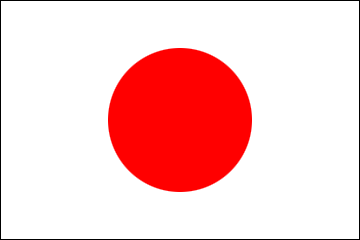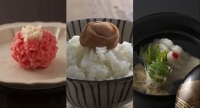Japanese Kitchen
2021/4/16
We have made much progress visiting the various prefectures of Japan in our Japanese Kitchen series, but have yet to discuss the capital city Tokyo. Home to more than 37 million residents, the Greater Tokyo Area is the most populous metropolitan area in the word. With preparations for the rescheduled Tokyo 2020 Olympic and Paralympic Games underway, Tokyoites are getting ready to be very much in the spotlight over the summer!
Shogakai (ginger fried pork)
by Dipika Soni
Japan Information and Cultural Centre
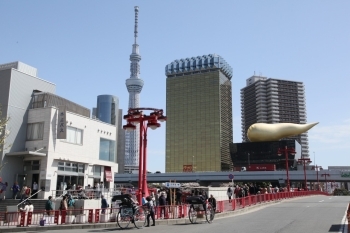 Like many people, my image of Tokyo was always one of a buzzing, neon, futuristic city. Indeed, for the majority of my childhood I imagined that most of Japan was a sprawling metropolis! My first stay in Tokyo didn’t disappoint as I spent a weekend in the bustling central area of Shinjuku in preparation for my stint as an ALT on the JET Programme (see my previous article about Ishikawa Prefecture here). The tall skyscrapers and row after row of bright flashing shop-signs and electronic sounds was everything I had imaged about Tokyo. However, it wasn’t until subsequent visits that I discovered the many different sides to Tokyo that I had at first missed.
Like many people, my image of Tokyo was always one of a buzzing, neon, futuristic city. Indeed, for the majority of my childhood I imagined that most of Japan was a sprawling metropolis! My first stay in Tokyo didn’t disappoint as I spent a weekend in the bustling central area of Shinjuku in preparation for my stint as an ALT on the JET Programme (see my previous article about Ishikawa Prefecture here). The tall skyscrapers and row after row of bright flashing shop-signs and electronic sounds was everything I had imaged about Tokyo. However, it wasn’t until subsequent visits that I discovered the many different sides to Tokyo that I had at first missed.
After many repeated visits, my favourite area of Tokyo without a doubt is Asakusa. I love the shitamachi downtown vibe and although much development has taken place in the run-up to the Olympics, the area still maintains its local, old-school feel. At the heart is the temple complex of Sensoji, with its well-photographed Kaminari gate. There are many bargains to be had at the various souvenir shops which line the approach to the temple, but across the Asakusa area in general you can find many traditional washoku and in particular wagashi merchants which makes it a foodie heaven! Towering over the area is Japan’s tallest structure (and the second tallest structure in the world) – Tokyo SkyTree. The tower was completed in 2012 and is a popular tourist destination for its views across Tokyo from the tower’s observation deck.
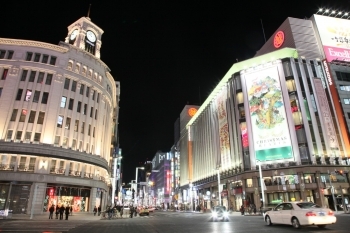 Other great places in Tokyo that I love to walk around are Meiji Jingu – an oasis of green in the city, Ueno with its leafy park, museums and Ameyoko market, and Ginza for the many department stores and famous Kabukiza – a must visit for theatre lovers! It is from Ginza that I have picked up a recipe to share, although some people may be surprised by the connection! Shogayaki (ginger fried pork) is a staple of many a Japanese set lunch or bento box. It is a simple but tasty dish which goes exceptionally well with a bowl of rice! Curiously, the birth of this countrywide-loved dish is said to be from a restaurant in Ginza in the 1950s.
Other great places in Tokyo that I love to walk around are Meiji Jingu – an oasis of green in the city, Ueno with its leafy park, museums and Ameyoko market, and Ginza for the many department stores and famous Kabukiza – a must visit for theatre lovers! It is from Ginza that I have picked up a recipe to share, although some people may be surprised by the connection! Shogayaki (ginger fried pork) is a staple of many a Japanese set lunch or bento box. It is a simple but tasty dish which goes exceptionally well with a bowl of rice! Curiously, the birth of this countrywide-loved dish is said to be from a restaurant in Ginza in the 1950s.
In Japanese, shoga means ginger and yaki means to grill or fry, and although other meats can be used, the term shogayaki generally refers to ginger fried pork. Thin slices of pork loin are marinated and pan-fried until golden brown, often served with shredded cabbage, and almost always alongside a steaming bowl of white rice. Why not give it a go yourself with this simple recipe below!
Japan Information and Cultural Centre
 Like many people, my image of Tokyo was always one of a buzzing, neon, futuristic city. Indeed, for the majority of my childhood I imagined that most of Japan was a sprawling metropolis! My first stay in Tokyo didn’t disappoint as I spent a weekend in the bustling central area of Shinjuku in preparation for my stint as an ALT on the JET Programme (see my previous article about Ishikawa Prefecture here). The tall skyscrapers and row after row of bright flashing shop-signs and electronic sounds was everything I had imaged about Tokyo. However, it wasn’t until subsequent visits that I discovered the many different sides to Tokyo that I had at first missed.
Like many people, my image of Tokyo was always one of a buzzing, neon, futuristic city. Indeed, for the majority of my childhood I imagined that most of Japan was a sprawling metropolis! My first stay in Tokyo didn’t disappoint as I spent a weekend in the bustling central area of Shinjuku in preparation for my stint as an ALT on the JET Programme (see my previous article about Ishikawa Prefecture here). The tall skyscrapers and row after row of bright flashing shop-signs and electronic sounds was everything I had imaged about Tokyo. However, it wasn’t until subsequent visits that I discovered the many different sides to Tokyo that I had at first missed.After many repeated visits, my favourite area of Tokyo without a doubt is Asakusa. I love the shitamachi downtown vibe and although much development has taken place in the run-up to the Olympics, the area still maintains its local, old-school feel. At the heart is the temple complex of Sensoji, with its well-photographed Kaminari gate. There are many bargains to be had at the various souvenir shops which line the approach to the temple, but across the Asakusa area in general you can find many traditional washoku and in particular wagashi merchants which makes it a foodie heaven! Towering over the area is Japan’s tallest structure (and the second tallest structure in the world) – Tokyo SkyTree. The tower was completed in 2012 and is a popular tourist destination for its views across Tokyo from the tower’s observation deck.
 Other great places in Tokyo that I love to walk around are Meiji Jingu – an oasis of green in the city, Ueno with its leafy park, museums and Ameyoko market, and Ginza for the many department stores and famous Kabukiza – a must visit for theatre lovers! It is from Ginza that I have picked up a recipe to share, although some people may be surprised by the connection! Shogayaki (ginger fried pork) is a staple of many a Japanese set lunch or bento box. It is a simple but tasty dish which goes exceptionally well with a bowl of rice! Curiously, the birth of this countrywide-loved dish is said to be from a restaurant in Ginza in the 1950s.
Other great places in Tokyo that I love to walk around are Meiji Jingu – an oasis of green in the city, Ueno with its leafy park, museums and Ameyoko market, and Ginza for the many department stores and famous Kabukiza – a must visit for theatre lovers! It is from Ginza that I have picked up a recipe to share, although some people may be surprised by the connection! Shogayaki (ginger fried pork) is a staple of many a Japanese set lunch or bento box. It is a simple but tasty dish which goes exceptionally well with a bowl of rice! Curiously, the birth of this countrywide-loved dish is said to be from a restaurant in Ginza in the 1950s.In Japanese, shoga means ginger and yaki means to grill or fry, and although other meats can be used, the term shogayaki generally refers to ginger fried pork. Thin slices of pork loin are marinated and pan-fried until golden brown, often served with shredded cabbage, and almost always alongside a steaming bowl of white rice. Why not give it a go yourself with this simple recipe below!
Shogayaki (ginger fried pork) recipe
Ingredients (serves 2)
Instructions
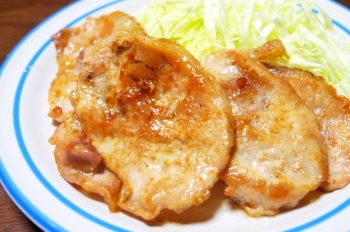
1. Grate the onion and ginger (add minced garlic according to taste).
2. Mix the ingredients for the marinate together (add sugar according to taste).
3. Season the meat with salt and pepper.
4. Heat the oil in a frying pan on a medium-high heat. When the pan is hot, cook the meat and flip over once the bottom is golden brown.
5. When both sides are golden brown, add the marinade and chopped spring onion. Take care not to overcook the meat and serve while hot!
- 6 thin slices of pork loin
- ¼ onion
- 1 clove garlic (optional)
- 1 knob ginger (or 1 tsp grated ginger)
- Salt & black pepper to taste
- 1 Tbsp cooking oil
- 1 spring onion (finely chopped)
- 2 Tbsp soy sauce
- 2 Tbsp mirin
- 2 Tbsp sake
- 1 tsp sugar (optional)
Instructions

1. Grate the onion and ginger (add minced garlic according to taste).
2. Mix the ingredients for the marinate together (add sugar according to taste).
3. Season the meat with salt and pepper.
4. Heat the oil in a frying pan on a medium-high heat. When the pan is hot, cook the meat and flip over once the bottom is golden brown.
5. When both sides are golden brown, add the marinade and chopped spring onion. Take care not to overcook the meat and serve while hot!
